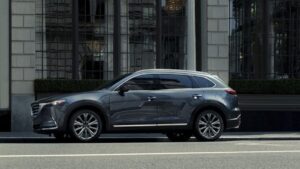Tundra vs. Tacoma: Comparing Toyota Pickup Trucks

If you’re looking for a new Toyota pickup truck, you have a decision to make: the Tundra or the Tacoma. The Tacoma is the smaller of the two, competing in the mid-size pickup segment, and the Tundra is a full-size truck that goes up against the American automakers’ popular pickup offerings including the Ford F-150 and Chevy Silverado 1500.
The Tundra was redesigned for the 2022 model year for the first time in a while, and the Tacoma enters a new generation for 2024. The Tundra is on sale now and the 2024 Tacoma is scheduled to reach U.S. dealerships in late 2023. To help you make your decision, here we’re examining the similarities and differences between the two models in terms of price, size, capabilities, and more.
Cab and Bed Sizes
The smaller Tacoma comes in either a two-door Xtra Cab configuration or a four-door Double Cab. The Xtra Cab seats two passengers and offers some storage behind the front seats, while the Double Cab has a rear seat and can accommodate five passengers. The Xtra Cab has a 6-foot bed while the Double Cab offers the choice of either a 5-foot or a 6-foot bed.
All versions of the full-size Tundra have four doors. The Double Cab is the smaller of the two, while the CrewMax offers larger rear doors and more space for rear-seat passengers. There are three bed lengths available: the Double Cab offers either a 6.5-foot or an 8.1-foot bed, while the CrewMax comes with either a 5.5-foot short bed or the 6.5-foot bed.
Engines and Transmissions
Although the old Tundra came with a V-8 and the Tacoma previously offered a V-6 engine, Toyota has changed things up under the hood for the latest generations. The Tundra is now available only with a turbocharged V-6 while the Tacoma’s sole engine choice is now a turbocharged four-cylinder. But the new, smaller turbo engines offer more power than their predecessors, and both trucks offer hybrid options, which Toyota calls i-Force Max, that boost power and torque.
The Tacoma’s standard engine is a turbocharged 2.4-liter inline-four with 228 horsepower. There’s a more powerful 278-hp version of this engine in higher trims, and the top hybrid version of the four-cylinder produces 326 hp. An eight-speed automatic transmission is standard in most models, but there’s a six-speed manual available on certain trim levels. When paired with the manual, the engine produces 270 horsepower.
The Tundra comes with a twin-turbocharged 3.4-liter V-6 either with or without hybrid assistance. The base version has 389 horsepower, while the i-Force Max hybrid has 437 horsepower.
Towing and Payload
As you’d expect, the bigger and more Tundra can tow and haul more than the Tacoma. It’s rated to tow up to 12,000 pounds in its SR5 Double Cab configuration with rear-wheel drive, and its payload capacity is up to 1940 pounds.
The Tacoma, meanwhile, is rated to tow up to 6500 pounds and its payload capacity is up to 1709 pounds. Toyota hasn’t yet released details on the Tacoma’s capabilities, so we don’t know exactly which configurations these maximum numbers apply to.
Off-Road Capabilities
Toyota has built its reputation for off-roading largely on the strength of the TRD Pro trim levels, and both the Tacoma and the Tundra offer this variant that features numerous upgrades meant for traversing different types of terrain. The TRD Pro versions also have a more rugged appearance thanks to black trim, special colors, different wheels, and unique badging.
Four-wheel drive comes standard on the TRD Pro models but is optional on most other configurations of the Tacoma and Tundra. The Tundra and Tacoma’s TRD Pro trims are roughly comparable to each other in terms of off-road equipment. Both trucks equipped with this package feature lifted suspension setups with special Fox shocks and 33-inch all-terrain tires. Ground clearance is similar between the two, although the Tacoma’s smaller size may make it better for navigating narrower trails.
Pricing and Trim Levels
The Tundra’s wide range of trim levels goes from relatively affordable bare-bones models all the way up to fully loaded luxury trucks that can cost over $80,000. The current 2023 Tundra range includes:
SR ($40,760)SR5 ($46,265)Limited ($52,360)Platinum ($62,570)1794 Edition ($63,255)TRD Pro ($72,715)Capstone ($79,440)
Toyota hasn’t yet released pricing for the 2024 Tacoma, but it will undoubtedly be cheaper than the Tundra. We’re estimating pricing ranging from around $28,000 for a base model up to around $50,000 for a TRD Pro.




